MODELING OF FREE JUMPS DOWNSTREAM SYMMETRIC AND ASYMMETRIC EXPANSIONS: THEORITICAL ANALYSIS AND METHOD OF STOCHASTIC GRADIENT BOOSTING*
MOHAMED A. Nassar
Water and Water Structures Engineering Department, Faculty of Engineering, Zagazig University, Zagazig, Egypt, E-mail: nasserzagazig@yahoo.com
(Received February 12, 2009, Revised October 19, 2009)
MODELING OF FREE JUMPS DOWNSTREAM SYMMETRIC AND ASYMMETRIC EXPANSIONS: THEORITICAL ANALYSIS AND METHOD OF STOCHASTIC GRADIENT BOOSTING*
MOHAMED A. Nassar
Water and Water Structures Engineering Department, Faculty of Engineering, Zagazig University, Zagazig, Egypt, E-mail: nasserzagazig@yahoo.com
(Received February 12, 2009, Revised October 19, 2009)
The general computational approach of Stochastic Gradient Boosting (SGB) is seen as one of the most powerful methods in predictive data mining. Its applications include regression analysis, classification problems with/without continuous categorical predictors. The present theoretical and experimental study aims to model the free hydraulic jump created through rectangular Channels Downstream (DS) symmetric and asymmetric expansions using SGB. A theoretical model for prediction of the depth ratio of jumps is developed using the governing flow equations. At the same time, statistical models using linear regression are also developed. Three different parameters of the hydraulic jump are investigated experimentally using modified angled-guide walls. The results from the modified SGB model indicate a significant improvement on the original models. The present study shows the possibility of applying the modified SGB method in engineering designs and other practical applications.
Stochastic Gradient Boosting (SGB), free jump, symmetric, asymmetric, theoretical, regression, experiment
1. Introduction
The hydraulic jump is a naturally occurring phenomenon commonly associated with what one sees in rivers. Many examples of hydraulic jumps can be seen at the outlet of gravity dams, downstream of bridges and culverts during periods of high flow and downstream of regulators. Early researches into hydraulic jumps focused on bulk parameters such as roller and jump lengths and depth ratios. Over the past decades, the characteristics of hydraulic jumps formed in expanding channels were studied. Notable progresses were made by Rajaratnam and Subramanya[1], Hager[2]Smith[3], Yan et al.[4]and Breman and Hager[5]. Hager et al.[6]conducted a thorough investigation into the length of the roller occurring in various hydraulic jumps. Ohtsu and Yasuda[7]investigated the properties of jumps of types B and D and obtained equations for sequent depth and roller length under these conditions. Herbrand[8]investigated the spatial jumps in expanding channels, formed at the expansion section or downstream from it. A simple empirical relation for calculating the sequent depth ratio was suggested as:

where y2is the sequent depth of jumps in expanding channels,y?is the depth ratio of classical jumps in prismatic channels, and e is the expansion ratio. The repelled jump (R-jump) is formed in a downstream channel. Using the dimensional analysis, the following functional relationships can be easilyproved for R-jump, Rajaratnam and Subramanya[1]:

in which ytis the tail water depth,ygis water depth below the gate, and Fgis the Froude number below the gate.
A number of theoretical and numerical models were proposed to investigate the sequent depth ratio and length of various forced hydraulic jumps, for example, Hager[9], and Chippada[10]. Zhou[11]presented a flow model for predicting a hydraulic jump in a straight open channel, with a model based on the general 2-D shallow water equations in the strong conservation form. Steinr¨uck et al.[12]developed a numerical model for low Froude number undular jumps with fully developed turbulent inflow. Quraishi and Al-Brahim[13]presented predictive mathematical models of hydraulic jump in a rectangular sloping channel with positive or negative steps. Husain et al.[14]extended the work of Quraishi and Al-Brahim with a set of regressed results to predict the length and depth ratio of hydraulic jumps in sloping rectangular channels based on experimental data. Negm[15]simplified the solution presented by Quraishi and Al-Brahim by applying the 1-D momentum and continuity equation. Negm[16]developed semi-theoretical expressions to detect possible cavitations near the steps in rectangular sloping stilling basins.
A number of experimental and numerical models were proposed to investigate both the flow field and the sediments through open channels. Tang et al.[17]investigated numerically the secondary flows and sedimentations behind a spur dike. Bai et al.[18]presented a fully conservative form to be applied to a coupled system of 2-D water flow and solute motion. Zhang et al.[19]developed a numerical model for flow motion with vegetation.
The present article aims to model the free hydraulic jump created through rectangular channels downstream symmetric and asymmetric expansions using stochastic gradient boosting. In addition, the article aims to carefully design a modified tool to control the flow parameters. The proposed tool is angled guide walls. Further, a new theoretical model for predicting the depth ratios of free hydraulic jump is proposed. The performance of the present models is compared to the experimental results. Finally, statistical regression equations are derived to predict the flow characteristics.
2. Problem formulation
In Egypt, multi-vent regulators are widely used to control the flow and discharge in irrigation canals and across the River Nile. During maintenance periods, some vents may be closed and others are kept open. Under symmetric and asymmetric operations of the gates, one may found flows similar to the flow in non-prismatic channels. The closing of the extreme gates (from both sides) is a case of flow by symmetric expansion while the closing of the gates at one side only (from left or from right) is a case of flow by asymmetric expansion. Appropriate models are necessary to simulate the flow through symmetric and asymmetric expansions.
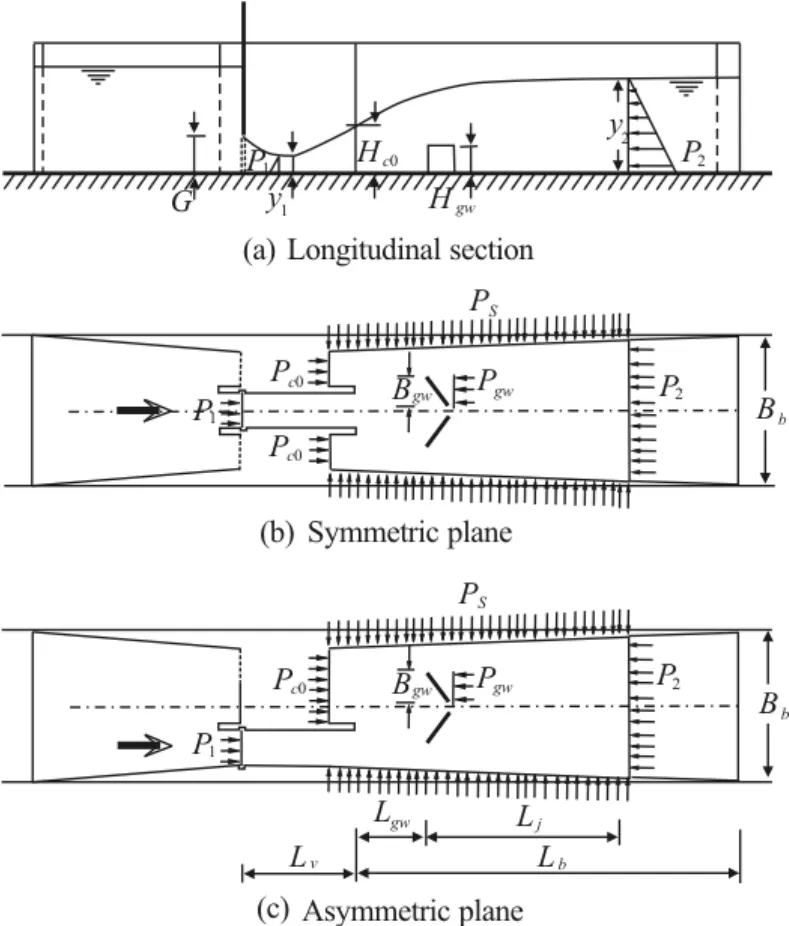
Fig.1 Schematic diagram of the experimental model
2.1 Experimental setup and procedure
Experiments were carried out in the Hydraulics Laboratory of the Faculty of Engineering, Zagazig University, Egypt. The re-circulating laboratory flume is 0.3 m wide, 0.468 m deep with an overall length of 15.6 m. The middle part of the model consists of a working section, 0.3 m wide, 0.355 m deep and 0.23 m in length ( Fig.1). A total of about 200 runs were performed, with the total time of each run of about 30 min. During each run the water surface profile was recorded. The experimental program is summarized as in Table 1. (1) To explore the effect of expansion ratios on the different flow characteristics. This stage includes the symmetric and asymmetric expansion ratios. (2) To explore the effect of the location ofguide walls on the different flow characteristics. (3) To explore the effect of the height of guide walls at the best location on the flow characteristics.

Table 1 Experimental setup and procedure
2.2 The relationships between flow parameters
An expression is obtained through dimensional analysis relating different parameters affecting the phenomena. The general relationship may be written as follows.

in which Bbis the basin width,Bgwthe projection of the guide walls, Bcothe total width of the abutments, B1the channel width at the initial depth, Lbthe stilling basin length, Lgwthe distance from the gate to guide walls, Hgwthe height of guide walls, α the deflection angle of guide walls, V1the mean velocity at the initial depth, y1the initial depth of jumps,ρ the water density, and ν the kinematic viscosity. The function for the free jump depth ratio can be written as follows:

in which y2/y1is the relative jump depth, F1the initial Froude number, F1=V1/(gy1)0.5,Lgw/Lbis the relative position of the guide walls, Lgw/Lb=Lr. Hgw/y1is the relative height of guide walls, Hgw/y1=Hr, and e is the expansion ratio, e=B1/Bb.
3. Discussion of experimental measurements
The relations between the initial Froude number F1and the relative jump length (y2/y1), between F1and the relative energy loss (Lj/y1), and between F1and (ΔE/ E1) in case of symmetric expansion ratios are shown for expansion ratios e= 1.4, 1.7, 2.1, 3.1 and 4.2 in Fig.2. In case of asymmetric expansion ratios, the relationship betweenF1and various jump parameters are shown for expansion ratios e=2.1, 3.1 and 4.2 in Fig.3. For both types of expansion ratios, it can be seen that y2/y1, Lj/y1andΔE/ E1all increase asF1increases. In addition, y2/y1and Lj/y1decrease as the expansion ratio increases. On the other hand, the relative energy lossΔE/ E1increases as the expansion ratio increases. In case of symmetric expansion ratios, the largest expansion ratio e=4.2 gives the smallest y2/y1and Lj/y1, but the largest energy loss (Fig.2). In case of asymmetric expansion ratios, the largest expansion ratio e=4.2 gives the smallest depth ratio and relative jump length, but the largest energy loss (Fig.3).
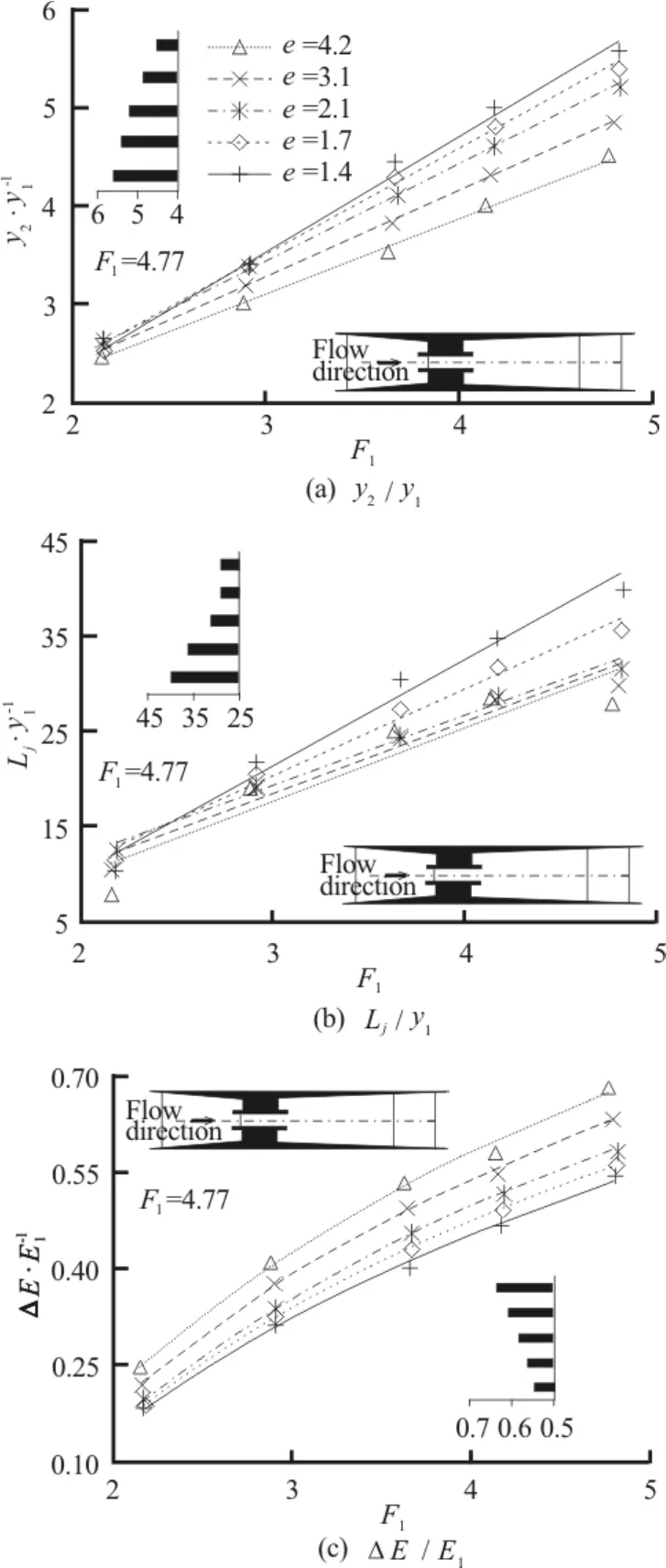
Fig.2 Relative jump characteristics for different symmetric expansion ratios
During the experiment, it was found that the flow leaves the opening vent in a jet form but then the flow spreads. With the smallest expansion ratio, the flow spreads only in a small channel width, which indicates that the flow velocity is large enough, therefore, the rate of the energy loss is very small compared to the case of larger expansion ratios.
3.1 The relative position of guide walls (Lgw/Lb)
It is suggested that the guide walls play the following three important roles: (1) they serve as sub-current controllers, (2) they re-distribute the flow and make it uniform across the lateral direction, especially for the case of asymmetric expansion ratios and (3) they serve as breakers for dead zones. The relationships between F1and parameters y2/y1, Lj/y1and ΔE/ E1are shown for different relative positions of guide walls (Lgw/Lb=0.1, 0.2, 0.3, 0.4 and 0.6) ( Fig.4). In case of the symmetric expansion ratio (e=4.2), it can be seen that y2/y1, Lj/y1and ΔE/ E1all increase as F1increases. It was found that, the guide walls with Lgw/Lb=0.2 reduce both y2/y1and Lj/y1to the smallest values.

Fig.3 Relative jump characteristics for different asymmetric expansion ratios
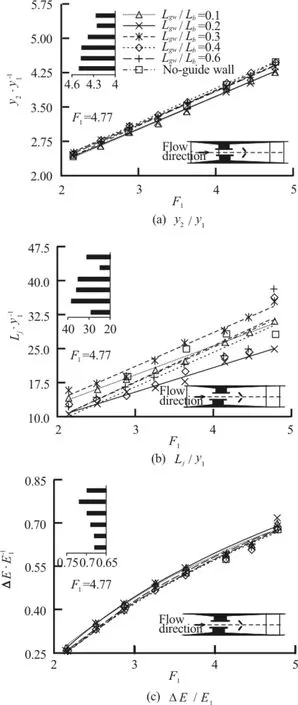
Fig.4 Relative jump characteristics for different positions of guide walls in case of symmetric expansion ratios, e=4.2
On the other hand, the largest value of ΔE/ E1is obtained for Lgw/Lb=0.2. It can be said that, locating the guide walls at an optimal position will reduce both y2/y1and Lj/y1as compared to the case without guide walls by about 15%, while it increases the energy loss by about 6%.
The guide walls act as a deviating tool for the flow turbulence and the commutative collision between the guide walls and the main flow jet increases the dissipated energy and damps the flow itself.
The damping effect of the guide walls is mainly related to the flow velocity, which increases within the first stage of the hydraulic jump. The stilling basin is divided into two zones: Zone (I), within the first quarter of the basin downstream the piers, Zone (II), behind Zone (I) , including the rest of the stilling basin. In case of locating the guide walls within Zone (I), we will very nearly have the initial free jump depth. Consequently, it minimizes the wake zones, created around the guide walls, which reduces the flow velocity and improves the flow distribution. The flow is clearly converted to a uniform type within the first half basin and consequently, the efficiency of the guide walls is increased. When the guide walls locate within Zone (II), as far away to some extent from the initial depth of the jump, the effectiveness of the guide walls as a flow-turbulences damper is reduced and the energy dissipated is decreased. On the other hand, the area of side-wake zones increases as compared to that of Zone (I), and the flow velocity increases. As a result, the guide walls’ advantages are lost.
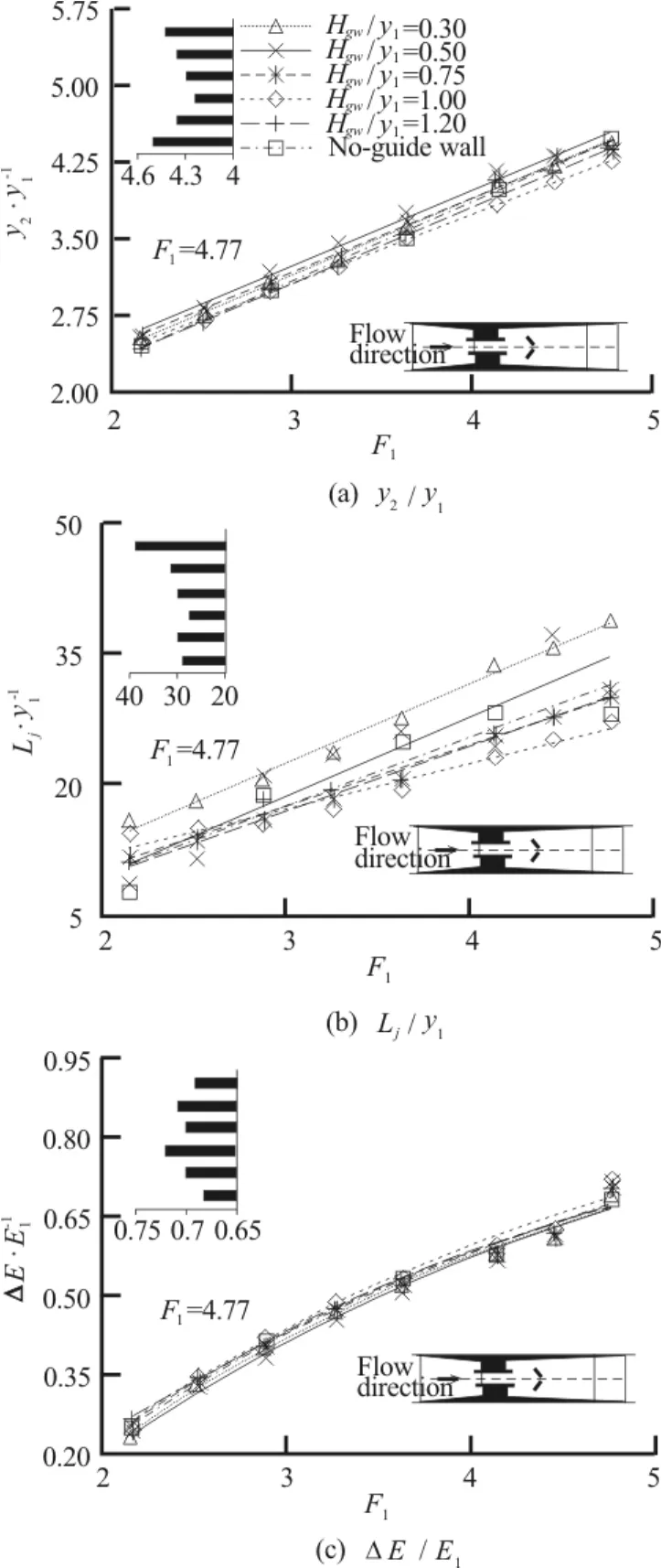
Fig.5 Relative jump characteristics for different heights of guide walls in case of symmetric expansion ratios, e=4.2
3.2 The relative height of guide walls (Hgw/y1)
Figure 5 shows the relationships between F1and y2/y1, Lj/y1and ΔE/ E1for different heights of guide walls in case of symmetric expansion ratios. The effect of the height of guide walls on the flow characteristics is examined for five height values as Hgw/y1=0.3, 0.5, 0.75, 1.0 and 1.2 for the same expansion ratio, e=4.2. It can be seen that, the case of Hgw/y1=1.0 gives the smallest values for both y2/y1and Lj/y1, while gives the largest value for the relative energy loss ΔE/ E1.
4. Stochastic Gradient Boosting (SGB)
4.1 An introduction to SGB
It is highly required to predict some hydraulic parameters such as the relative depth ratio in the design of most of the hydraulic structures. Theoretical modeling of these hydraulic structures would be very difficult if not impossible. Also, the numerical modeling of these parameters is also a very hard task. A relatively new computational technique was developed and being widely applied to engineering and social sciences. This promising technique is the Stochastic Gradient Boosting (SGB). However, it may be difficult for one not specialized in this technique to develop a software for their own prediction problems. One may use the available SGB software. SGB was implemented through the gbm7 package, Ridgeway[20], which may be used to build SGB models to predict the relative jump depth.
There are very few published applications of SGB. Lawrence et al.[21]illustrated the use of SGB as a refinement of classification tree analysis in a remote sensing problem. Application in other fields includes discrimination of freshwater residency in a coastal fishery from scales collected from sub adult fish, Cappo et al.[22], microscopy image analysis of bread, Lindgren and Rousu[23], graphical estimation of a slate deposit, Matias et al.[24], and calibration of spectroscope measurements of organic chemicals in plant samples, Sheperd et al.[25].
Boosting is a technique for improving the accuracy of a predictive function by applying the function repeatedly in a series and combining the output of each function with weighting so that the total error of the prediction is minimized. In many cases, the predictive accuracy of such a series is greatly improved as compared with the base function used alone.
The boost algorithm was developed by Friedman[26]and is optimized in this article to improve the accuracy of models built on decision trees. The boost algorithm consists of series of trees. The first tree is fitted to the data. The residuals (error values) from the first tree are then fed into the second tree to reduce the error. This process is repeated through a series of successive trees. The final predicted value is formed by adding the weighted contribution of each tree. Boost model can be described as:

where F0is the starting value for the series, S is a vector of residual values remaining at this point in the series, T1( S), T2( S) are trees fitted to the residuals andx1, x2, etc. are coefficients of the tree node predicted values that are obtained by the boost algorithm.
4.2 Development of SGB model
Friedman[26,27]and Ridgeway[20]provided guidelines on appropriate settings for model fitting options. These recommendations coupled with preliminary analyses conducted on an independent data set led to the following option settings.
(1) The interaction depth, which controls the number of nodes in the tree is set at 10 nodes.
(2) Bagging fraction that controls the fraction of the training data is set at 0.3 for these analyses.
(3) Shrinkage rate that controls the learning speed of the algorithm is set at 0.05.
(4) Number of trees in series is 400.
Training fraction sets aside a portion of the data for computing an out-of-sample estimate of the loss function. As an independent test set is already established before beginning the modeling exercises, the training fraction is left at its default value of 1.0, and the out-of-bag method is used for determining the optimal number of boosting iterations.
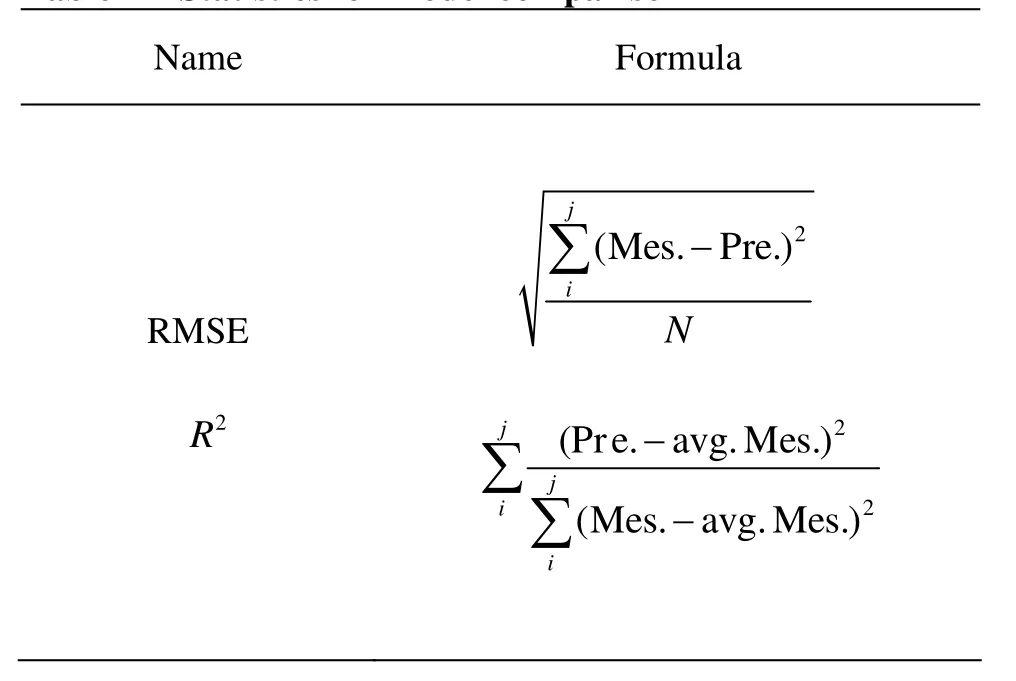
Table 2 Statistics for model comparison
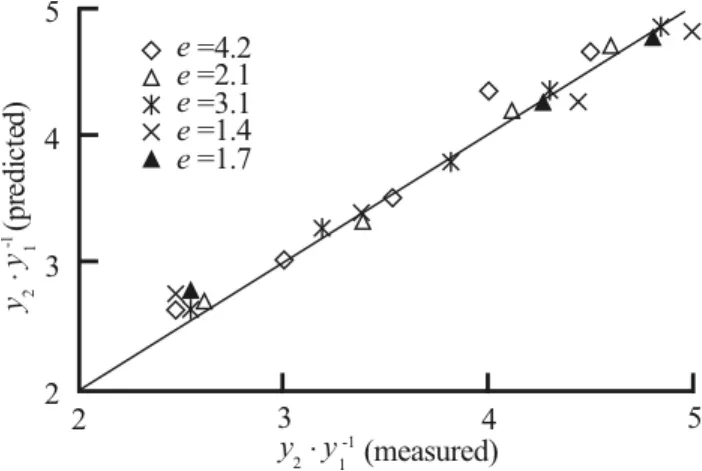
Fig.6 Relationship between experimental measurements and SGB model for different symmetrical expansion ratios
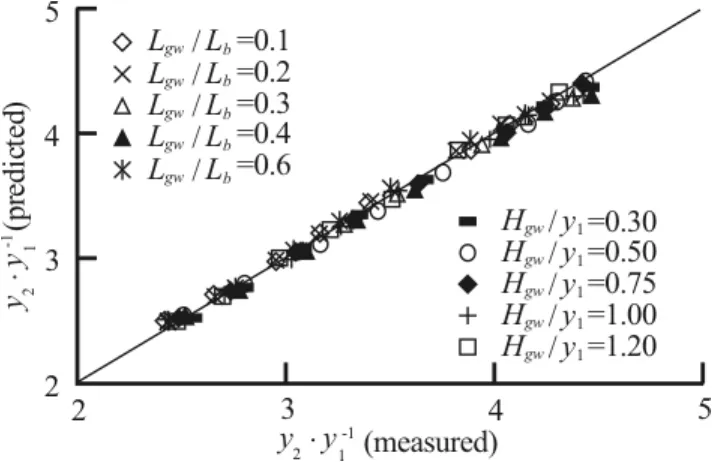
Fig.7 Relationship between experimental measurements and SGB model in the presence of guide walls in case of symmetrical expansion ratio, e=4.2
4.3 Evaluation of the developed SGB model
Evaluation criteria for the studied variables are based on correlation and relative Root Mean Squared Error (RMSE). The determination coefficient2R is the square of the correlation coefficient for two sets of data, paired up one-to-one. The RMSE is the root of the mean value of the squared difference between the actual target value and the predicted target value. The main equations of statistics used for the objective function are the ones presented in Table 2. The performance of the model to fit data and the ability of the network to generalize or extrapolate the results outside of the range of the learning set are measured. In addition, the presence of over fitting and the sensibility of the model to initial conditions are also considered. The errors due to the use of a specific combination of learning and validation sets are checked. The prediction made by the modified SGB model gives an estimate of the relative jump depth y2/y1in comparison to the experimental data, which is illustrated by two examples as shown in Figs.6 and 7. The determination coefficientR2for these data sets is between 0.976 and 0.994, while RMSE is between 0.004 and 0.019, indicating a good agreement between the model prediction and experimental data. Table 3 presents R2, and RMSE for all developed models. It can be said that the model proves very good as compared to the observations.
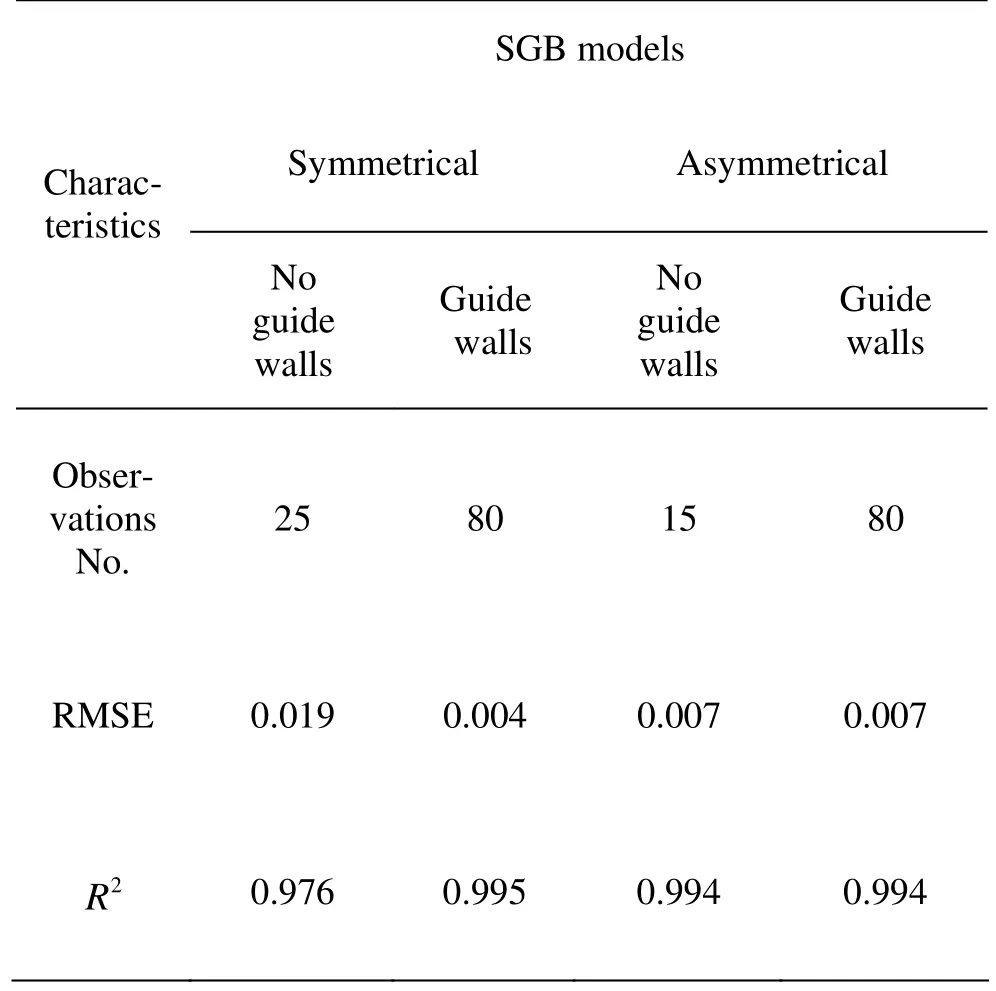
Table 3 Basic features of the developed SGB models
5. Theoretical study
Figure 1 shows the schematic diagram of a hydraulic jump in radial stilling basins. Two cases are presented, including symmetric and asymmetric expansions. The toe of the hydraulic jump is located upstream the expansion section. The jumps extend partly in the upstream and partly in the downstream channels. In formulating the general momentum equation, the pressure distribution is assumed as hydrostatic, the velocity distribution is assumed as uniform, the effect of turbulence and air entrainment, the effect of mixture of gradual expansion and sudden expansion and the effect of wall friction are all ignored and the tail-water depth is assumed to take the temporal mean value of its fluctuations. The momentum equation for the control volume between Sections 1 and 2 of Fig.1 can be written as:
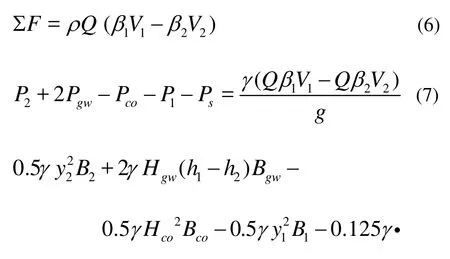
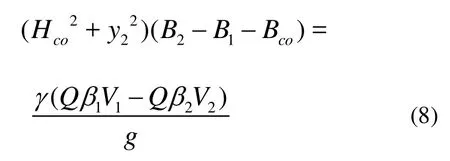
where P2is the hydrostatic pressure just after jump, Pgwis the hydrostatic pressure on the face of the guide walls, Pcois the hydrostatic pressure just after the abutments, P1is hydrostatic pressure just before jump, Psis the channel side pressure, B2is the channel width at the sequent depth andHcois the water depth just downstream the abutments. Assuming that, β1=β2=1.0 and applying the continuity equation between the two sections, we have

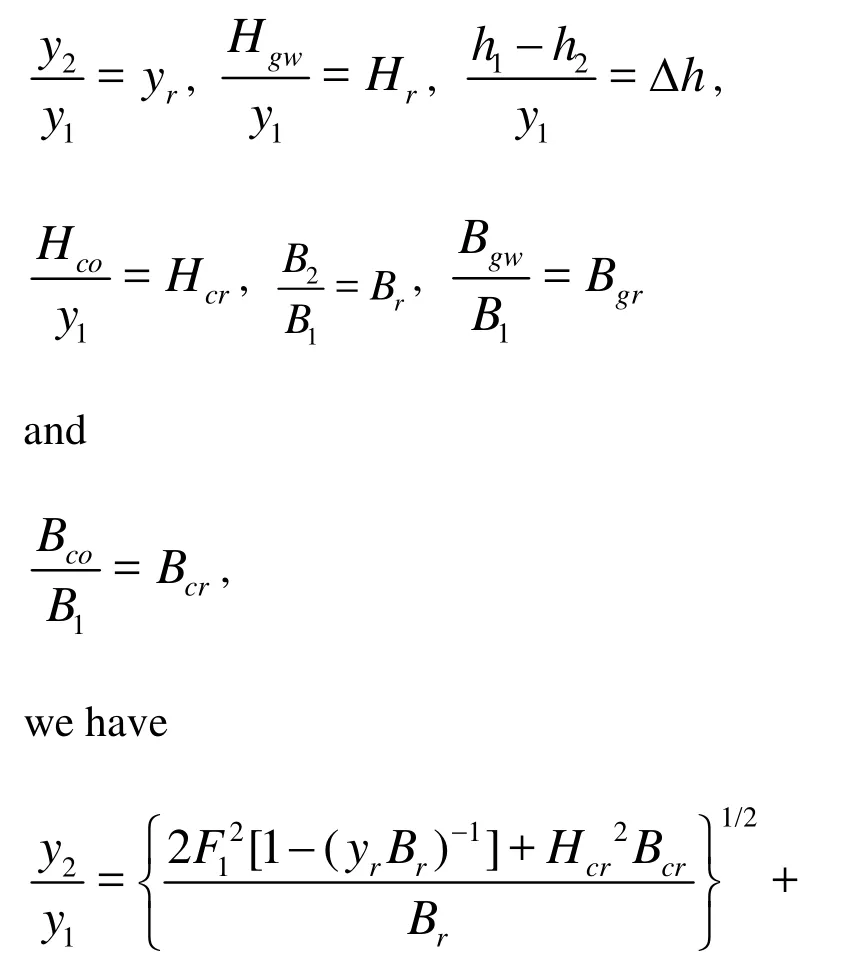

5.1 Calibration and verification
Experimental data are used to evaluate the theoretical model. For various values of expansion ratio e and various relative parameters of the guide walls, the sequent depth ratio y2/y1is computed from Eq.(10). Figures 8 and 9 show the relationship between the theoretical results and the measured experimental data for the symmetrical and asymmetrical expansion ratios, respectively. The results are in good agreement with the experimental data. The determination coefficientR2for the developed theoretical model is 0.979. The developed theoretical model is also compared to the experimental measurements in the presence of guide walls for symmetrical and asymmetrical expansion ratio e=4.2, as shown in Figs.10 and 11, respectively. The determination coefficientR2for these data sets is 0.979, while RMSE is 0.11.
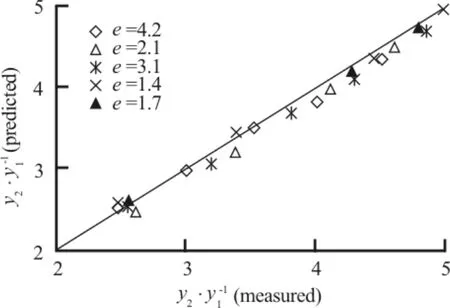
Fig.8 Relationship between experimental measurements and theoretical model Eq.(10) for various symmetrical expansion ratios
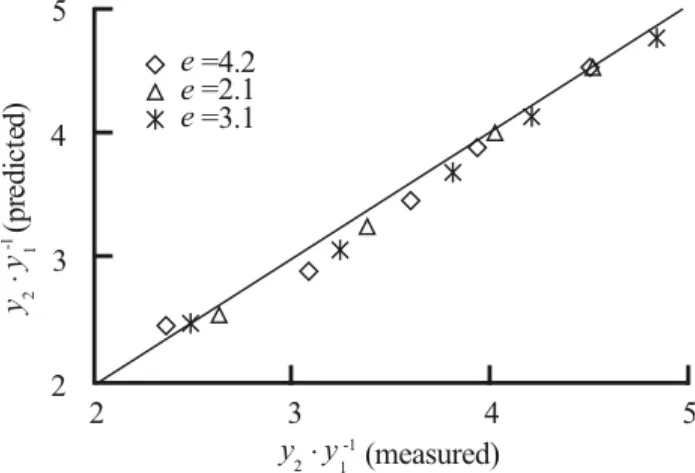
Fig.9 Relationship between experimental measurements and Eq.(10) for various asymmetrical expansion ratios
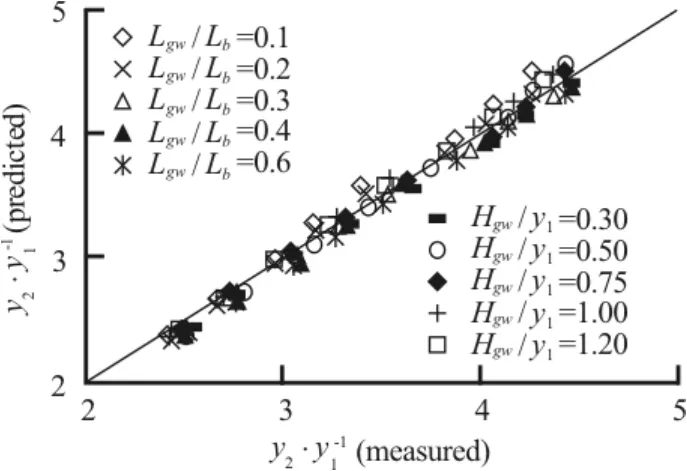
Fig.10 Relationship between experimental measurements and Eq.(10) in the presence of guide walls in case of symmetrical expansion ratio, e=4.2
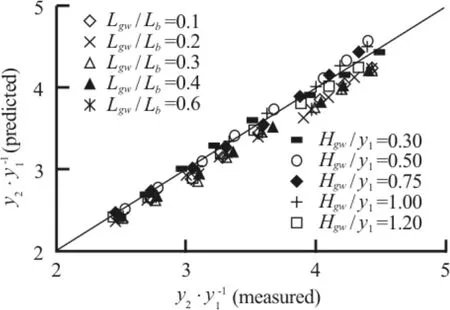
Fig.11 Relationship between experimental measurements and Eq.(10) in the presence of guide walls in case of asymmetrical expansion ratio, e=4.2
6. Statistical regression
DataFit V.9.0.59[28]is an engineering tool that simplifies the tasks of regression and statistical analysis. With DataFit and based on the experimental data, several statistical equations were used to predict y2/y1. The best statistical equations are Eqs.(11) and (12) for the symmetrical and asymmetrical expansion ratios in case of no guide walls, , respectively. For the case of guide walls, they are Eqs.(13) and (14) for the symmetrical and asymmetrical expansion ratio e=4.2, respectively.
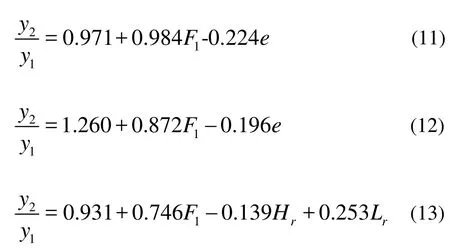

Figures 12-15 show a comparison between the measured y2/y1and the predicted ones using Eqs.(11)-(14), respectively, with an acceptable agreement. The regression statistics are listed in Table 4.
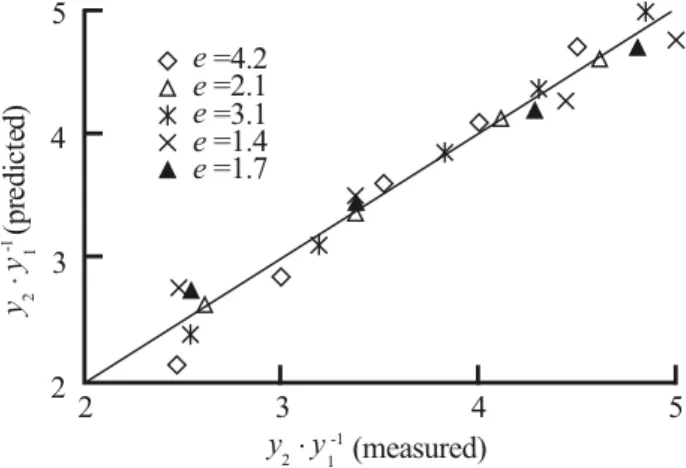
Fig.12 Relationship between experimental measurements and Eq.(11) for different symmetrical expansion ratios
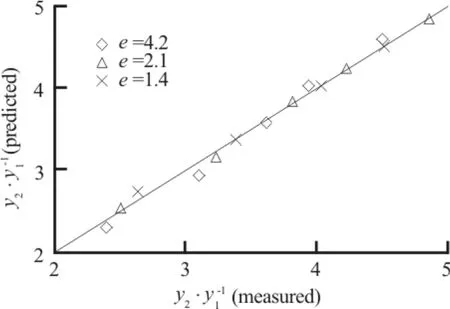
Fig.13 Relationship between experimental measurements and Eq.(12) for different asymmetrical expansion ratios
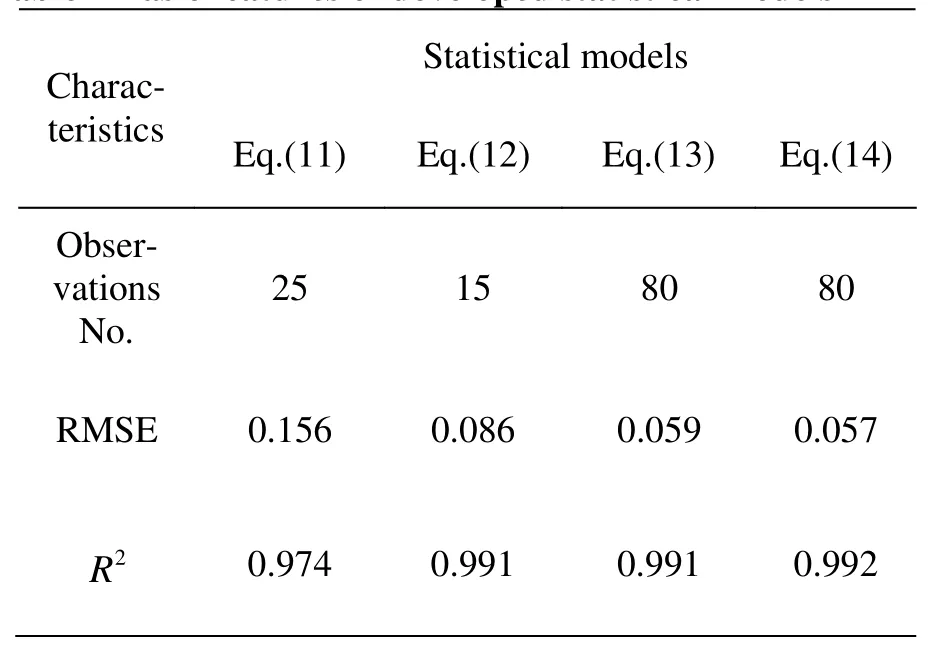
Table 4 Basic features of developed statistical models
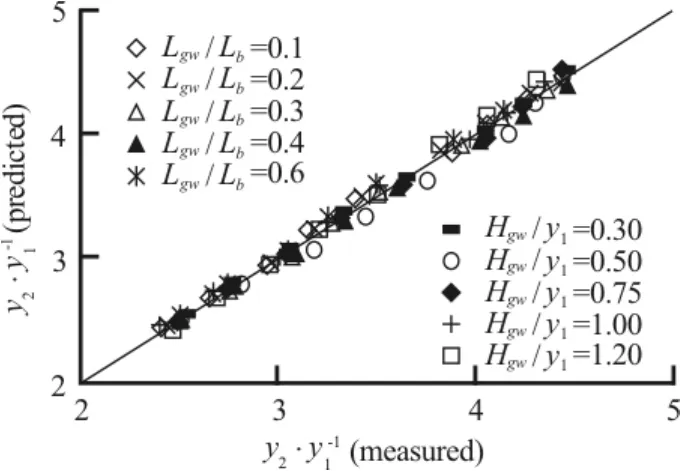
Fig.14 Relationship between experimental measurements and Eq.(13) in the presence of guide walls in case of symmetrical expansion ratio, e=4.2
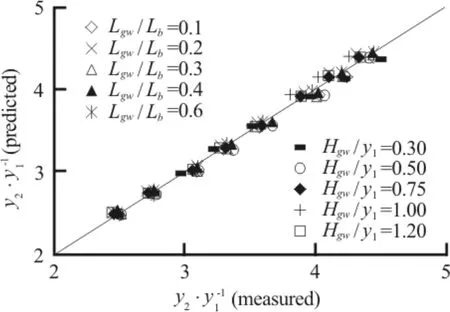
Fig.15 Relationship between experimental measurements and Eq.(14) in the presence of guide walls in case of asymmetrical expansion ratio, e=4.2
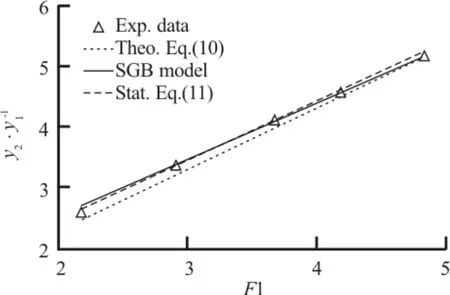
Fig.16 Comparison between different developed models and experimental measurements for the case of no guide wall and symmetrical expansion ratio, e=2.1
7. Comparison between the developed models
Performance of the developed prediction Eqs. (11) through (14) is compared with the theoretical Eq.(10) and SGB models. Figure 16 shows depth ratio y2/y1versus Froude number F1for the symmetrical expansion ratio e=2.1. It can be seen that the predicted sequent depth ratios obtained by SGB models and the statistical procedure are very close but slightly over as compared with those predicted by the theoretical model for the casesF1=2.15 to 4.0. It becomes lower than those predicted by the theoretical model for the rest of F1values.
It is clear that both statistical and SGB models give very good results as compared to the theoretical model because they are under a number of assumptions mentioned in the formulating stage due to lack of the measuring devices. The main assumptions that may affect the results include the velocity distribution is assumed to be uniform and neglecting the effect of turbulence and air entrainment.
8. Conclusions
The present theoretical and experimental study concerns three different models to simulate the free hydraulic jump created through rectangular channels downstream symmetric and asymmetric expansions, which include stochastic gradient boosting, theoretical and statistical models. A modified angled-guide walls were suggested as a tool to control flow parameters. The following conclusions are reached.
(1) For both symmetric and asymmetric expansions, y2/y1, Lj/y1and ΔE/ E1increase as F1increases.
(2) Both y2/y1and Lj/y1decrease while ΔE/ E1increases as the expansion ratio increases.
(3) The largest expansion ratio e=4.2 gives the smallest y2/y1and Lj/y1but the largest ΔE/ E1.
(4) The guide walls located within 20% of the stilling basin length and Hgw/y1=1.0 give the smallest y2/y1and Lj/y1, but the largest ΔE/ E1.
(5) The optimal guide walls reduce bothy2/y1and Lj/y1as compared to the case of no guide walls by about 15%. In contrast, ΔE/ E1is increased by about 6%.
(6) The derived theoretical equation gives results in a good agreement with the experimental data.
(7) A systematic methodology is proposed to develop SGB model to predict the relative jump depth. It is shown that the predictions of the relative jump depth could be substantially improved if SGB model are used in place of the statistical methods and theoretical models.
(8) The multi-tree SGB model is more satisfactory with the following settings: the interaction depth includes 10 nodes in the tree, bagging fraction is set at 0.3, shrinkage rate is 0.05 and number of trees in series is 400.
(9) The SGB model is a powerful computational tool for predicting the values of y2/y1. The proposed method has significant benefits for optimal use of stilling basins.
References
[1] RAJARATNAM N., SUBRAMANYA K. Hydraulic jumps below abrupt symmetrical expansions[J]. ASCE, Journal of Hydraulics Division, 1968, 94(HY3): 481-503.
[2] HAGER W. H. Hydraulic jumps in non-prismatic rectangular channels[J]. Journal of Hydraulic Research, 1985, 23(1): 21-35.
[3] SMITH G. D. The submerged hydraulic jump in an abrupt lateral expansion[J]. Journal of Hydraulic Research, 1989, 27(2): 257-266.
[4] YAN Zhong-min, ZHOU Chun-tian and LU Shi-qiang. Pressure fluctuations beneath spatial hydraulic jumps[J]. Journal of Hydrodynamics, Ser. B, 2006, 18(6): 723-726.
[5] BREMEN R., HAGER W. H. Expanding stilling basin[J]. Proc. ICE, Water, maritime and energy, 1994, 106(3): 215-228.
[6] HAGER W. H., BREMEN R. and KAWAGOSHI N. Classical hydraulic jump: Length of roller[J]. Journal of Hydraulic Research, 1990, 28(5): 591-608.
[7] OHTSU I., YASUDA Y. Hydraulic jump in sloping channels[J]. Journal of Hydraulic Engineering, 1991, 117(7): 905-921.
[8] HERBRAND K. The spatial hydraulic jump[J]. Journal Hydraulic Research, 1973, 11(3): 205-218.
[9] HAGER W. H. Classical hydraulic jump: Free surface profile[J]. Canadian Journal of Civil Engineering, 1993, 20(3): 536-539.
[10] CHIPPADA S., RAMASWAMY B. and WHEELER M. F. Numerical simulation of hydraulic jump[J]. International Journal for Numerical Methods in Engineering, 1994, 37(8): 1381-1397.
[11] ZHOU J. G., STANSBY P. K. 2D shallow water flow model for the hydraulic jump[J]. International Journal for Numerical Methods in Fluids, 1999, 29(4): 375-387.
[12] STEINR¨UCK H., SCHNEIDER W. and GRILLHOFER W. A multiple scales analysis of theundular hydraulic jump in turbulent open channel flow[J]. Journal of Fluid Dynamics Research, 2003, 33: 41-55.
[13] QURAISHI A. A., AL-BRAHIM A. M. Hydraulic Jump in Sloping Channel with Positive or Negative Step[J]. Journal of Hydraulic Research, 1992, 30(6): 769-782.
[14] HUSAIN D., ALHAMID A. A. and NEGM A. M. Length and depth of hydraulic jumps on sloping channels[J]. Journal of Hydraulic Research, 1994, 32(6): 899-909.
[15] NEGM A. M. Hydraulic jumps at positive and negative steps on sloping floors[J]. Journal of Hydraulic Research, 1996, 34(3): 409-420.
[16] NEGM A. M. Semi-theoretical approach for detecting of cavitatoin at steps in slopping stilling basinshydraulic jump type[C]. Proc. of 5th Int. Conf. on Hydro-Science and Engineering (ICHE2000). Seoul, Korea, 2000.
[17] TANG Xue-lin, DING Xiang and CHEN Zhi-cong. Experimental and numerical investigations on secondary flows and sedimentations behind a spur dike[J]. Journal of Hydrodynamics, Ser. B, 2007, 19(1): 23-29.
[18] BAI Lu-hai, JIN Sheng. A conservative coupled flow/transport model with zero mass error[J]. Journal of Hydrodynamics, 2009, 21(2): 166-175.
[19] ZHANG Jian-tao, SU Xiao-hui. Numerical model for flow motion with vegetation[J]. Journal of Hydrodynamics, 2008, 20(2): 172-178.
[20] RIDGEWAY G. The state of boosting[J]. Comp. Sci. Stat., 1999, 31: 172-181.
[21] LAWRENCE R., BUNN A. and POWELL S. et al. Classification of remotely sensed imagery using stochastic gradient boosting as a refinement of classification tree analysis[J]. Journal of Remote Sens. Environ., 2004, 90(3): 331-336.
[22] CAPPO M., DE’ATH G. and BOYLE S. et al. Development of a robust classifier of freshwater residence in barramundi (Lates calcarifer) life histories using elemental ratios in scales and boosted regression trees[J]. Marine Freshwater Res., 2005, 56(5): 713-723.
[23] LINDGREN J. T., ROUSU J. Microscopy image analysis of bread using machine learning methods[R]. Technical Report C-2002-68, University of Helsinki, 2002.
[24] MATIAS J. M., VAAMONDE A. and TABOADA J. et al. Support vector machines and gradient boosting for graphical estimation of a slate deposit[J]. Stoch. Environ. Res. Risk A, 2004, 18(5): 309-323.
[25] SHEPERD K. D., PALM C. A. and GACHENGO C. N. et al. Rapid characterization of organic resource quality for soil and livestock management in tropical agroecosystems using near-infrared spectroscopy[J]. Agron. Journal, 2003, 95: 1314- 1322.
[26] FRIEDMAN J. H. Greedy function approximation: A gradient boosting machine[J]. Ann. Stat., 2001, 29(5): 1189-1232.
[27] FRIEDMAN J. H. Stochastic gradient boosting[J]. Comput. Stat. Data An., 2002, 38(4): 367-378.
[28] DATAFIT V.9.0.59 DEVELOPMENT TEAM. Engineering tool for Statistical Computing and regression analysis[C]. Oakdale Engineering 23 Tomey Road Oakdale. 2008, PA 15071 USA, http://www.R-project.org..
10.1016/S1001-6058(09)60035-4
* Biography: MOHAMED A. Nassar (1975-), Male, Ph. D., Assistant Professor
 水動(dòng)力學(xué)研究與進(jìn)展 B輯2010年1期
水動(dòng)力學(xué)研究與進(jìn)展 B輯2010年1期
- 水動(dòng)力學(xué)研究與進(jìn)展 B輯的其它文章
- FLOW CHARACTERISTICS IN ENERGY DISSIPATION UNITS OF LABYRINTH PATH IN THE DRIP IRRIGATION EMITTERS WITH DPIV TECHNOLOGY*
- VIBRATION CHARACTERISTICS OF FLUID-STRUCTURE INTERACTION OF CONICAL SPIRAL TUBE BUNDLE*
- TURBULENT FLOWS AROUND SAND DUNES IN ALLUVIAL RIVERS*
- SIMULATION OF THE OIL SLICK MOVEMENT IN TIDAL WATERWAYS*
- SEEPAGE ABILITY OF HIGH-PRESSURE HOT COMPOSITE FOAM IN POROUS MEDIA*
- VISCOSITY EFFECTS ON THE BEHAVIOR OF A RISING BUBBLE*
